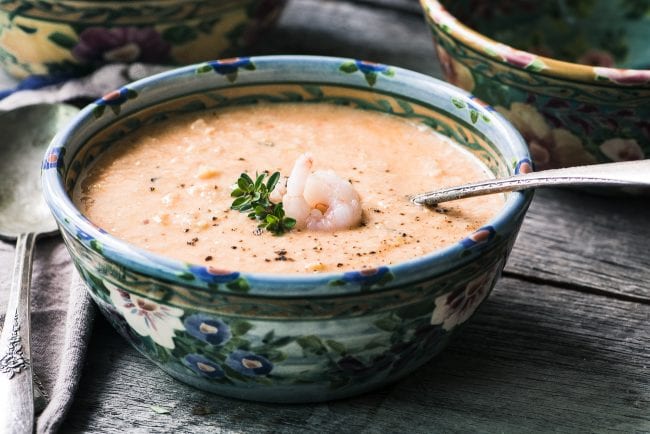Understanding Soup Varieties: Chowder, Soup, And Bisque

Soup is a versatile dish that comes in various forms, with chowder and bisque being two popular variations. While they all fall under the soup category, each of them has distinct characteristics that set them apart. Chowder is known for its chunky texture and hearty ingredients like potatoes and clams or corn. Soup, on the other hand, is often thinner in consistency and can have a wide range of ingredients. Bisque is a smooth and creamy soup, usually made with shellfish like lobster or crab. Understanding these varieties allows for a better appreciation of the diverse flavors and culinary traditions they each represent.
1 Definition And Characteristics Of Chowder
Chowder is a type of soup that is known for its chunky texture and rich, hearty flavors. It typically contains ingredients such as potatoes, onions, and a main protein like clams or corn. Chowder is often made with a creamy base, such as milk or cream, which gives it a thick and velvety consistency. Unlike other soups, chowder is usually made with a roux, a mixture of butter and flour, to create a thicker broth. The combination of tender chunks of ingredients and a creamy base makes chowder a comforting and satisfying dish.
2 Definition And Characteristics Of Soup
Soup is a versatile and popular type of dish that is enjoyed all around the world. It is defined as a liquid-based culinary creation made by simmering ingredients such as vegetables, meat, or seafood in a flavorful broth. Unlike chowder and bisque, soup does not have a specific consistency or texture. It can range from thin and watery to thick and hearty, depending on the ingredients and cooking method used. Soup is known for its ability to be easily customized with different flavors, spices, and garnishments, making it a go-to comfort food for many people.
Chowder Vs. Soup: Ingredients And Preparation

When it comes to ingredients and preparation, chowder and soup differ in their approach. Chowder often includes ingredients such as potatoes, onions, and other vegetables, along with seafood or meat. The ingredients are usually sautéed or cooked in bacon fat before being simmered in a creamy broth. On the other hand, soup can be made with a wide range of ingredients, including vegetables, meat, or seafood. The ingredients are typically simmered in a broth or stock. Soups can be easily customized with various flavors and spices to suit individual preferences.
1 Differences In Ingredients And Texture
Chowder and soup can be differentiated based on their ingredients and texture. Chowder typically includes ingredients like potatoes, onions, and other vegetables, along with seafood or meat. These ingredients are sautéed or cooked in bacon fat before being simmered in a creamy broth, resulting in a thick and hearty texture. On the other hand, soup can be made with a wide range of ingredients like vegetables, meat, or seafood. The ingredients are simmered in a broth or stock, resulting in a lighter and more liquid consistency.
2 Variation In Cooking Methods
In addition to differences in ingredients and texture, chowder and soup also vary in their cooking methods. Chowder is typically cooked using a combination of sautéing and simmering techniques. The ingredients are first sautéed in bacon fat or butter to enhance their flavors before being simmered in a creamy broth. On the other hand, soup is usually prepared by simmering the ingredients in a broth or stock. This allows the flavors of the ingredients to meld together and create a well-balanced soup. The variation in cooking methods contributes to the distinct characteristics and taste profiles of chowder and soup.
Bisque Vs. Chowder: Origins And Traditions

Bisque and chowder both have interesting origins and culinary traditions. The term “bisque” originated from the French word “biscuit,” which referred to a type of bread soaked in wine. Over time, the term evolved to describe a creamy, rich soup made with shellfish. Bisques are commonly associated with French cuisine and are often made with lobster, crab, or shrimp.
On the other hand, chowder has its roots in New England, particularly in coastal regions where seafood was abundant. It is believed to have been influenced by the early settlers and Native American tribes. Traditional New England chowder is typically made with clams or fish, combined with potatoes, onions, and salt pork. Chowder has become a beloved dish in American cuisine, with regional variations and creative adaptations found throughout the country.
Both bisque and chowder have their unique culinary traditions that have been passed down through generations, making them beloved and cherished soup styles.
1 Origin And History Of Bisque
Bisque has its origins in French cuisine, specifically in the 17th century. The term “bisque” is derived from the French word “biscuit,” which originally referred to a type of bread soaked in wine. Over time, the term evolved to describe a creamy, luxurious soup made with shellfish. Bisque was traditionally made using the shells of crustaceans like lobster or crab, which were simmered to extract their flavors and then blended with other ingredients such as cream or butter. Today, bisque remains a popular dish in French cooking and is enjoyed for its rich, velvety texture and delicate seafood flavors.
2 Culinary Significance Of Chowder
Chowder holds significant culinary significance in various regions across the world. Its rich and hearty nature makes it a comforting and satisfying dish, perfect for cold winters or seafood enthusiasts. Chowder has become a staple in coastal areas, where fresh seafood is abundant and readily available. It showcases the local flavors and ingredients, allowing for creative variations and exploring regional culinary traditions. Its versatility also allows for the inclusion of different types of seafood, vegetables, and spices, making it a versatile and customizable dish that can be enjoyed by people of all tastes and dietary preferences.
Flavor Profiles: Chowder, Soup, And Bisque

The flavor profiles of chowder, soup, and bisque vary significantly due to their unique ingredients and preparation methods. Chowders typically feature a rich and creamy broth, often made with milk or cream, that is infused with the flavors of chunky vegetables, herbs, and seafood. The combination of these ingredients creates a hearty and savory flavor profile. On the other hand, bisques are known for their smooth and velvety texture, achieved by pureeing shellfish and incorporating cream. This results in a more delicate and subtly sweet flavor profile that highlights the natural sweetness of the seafood. The choice between these three options ultimately depends on individual preferences and desired taste experiences.
1 Distinctive Flavors In Chowder
Chowder is renowned for its distinct flavors that set it apart from other soup varieties. The richness and creaminess of the broth, often made with milk or cream, creates a velvety base that enrobes the ingredients. The combination of chunky vegetables, herbs, and seafood adds depth and complexity to the flavor profile. Whether it’s a classic clam chowder or a hearty corn chowder, the flavors are bold and comforting, making every spoonful a delight for the taste buds. The distinctive flavors of chowder make it a beloved comfort food and a go-to option for soup lovers.
2 Flavor Profiles Of Soups And Bisques
Soups come in a wide variety of flavors, ranging from light and delicate to hearty and robust. Vegetable soups often feature fresh herbs and aromatic spices, while meat-based soups offer savory richness and depth. Creamy soups, such as tomato bisque or mushroom bisque, have velvety textures and indulgent flavors. Bisques, on the other hand, have an even more luxurious flavor profile. Typically made with shellfish like lobster or crab, bisques are rich in seafood essence and often enhanced with butter and cream. The result is a velvety smooth soup with a deep, complex flavor that delights seafood lovers.
Popular Varieties And Regional Influences

Popular varieties of chowder, soup, and bisque are influenced by regional cuisines and ingredients. In New England, clam chowder is a beloved classic, while Manhattan clam chowder features a tomato-based broth. In the Midwest, corn chowder is a popular choice, highlighting the region’s abundant corn crops. In the South, gumbo showcases a rich and flavorful soup with Cajun and Creole influences. Bisques are often associated with French cuisine, with lobster bisque being a luxurious delicacy. Each region brings its own unique flavors and ingredients to these soup styles, providing a diverse and delicious culinary experience.
1 Regional Chowder Varieties
Chowder varieties vary greatly based on regional influences and ingredients. In New England, clam chowder is a beloved classic, known for its creamy base and tender clams. The Pacific Northwest is famous for its salmon chowder, featuring chunks of fresh salmon in a rich and flavorful broth. In the South, shrimp and corn chowder is a popular choice, showcasing the region’s love for seafood and local produce. Each region brings its own unique twist to chowder, highlighting the local flavors and culinary traditions. Whether you prefer the creamy richness of New England or the heartiness of Pacific Northwest seafood, there’s a regional chowder variety to satisfy every palate.
2 Diverse Soup Creations
Soup is a versatile dish that allows for endless creativity and experimentation. There are countless diverse soup creations enjoyed around the world. From classic favorites like tomato soup and chicken noodle soup to exotic flavors like Thai coconut curry soup and French onion soup, the possibilities are endless. Soups can be made with a wide variety of ingredients, including vegetables, meats, seafood, legumes, and spices. Different cultures and cuisines have their own unique soup recipes, showcasing the flavors and culinary traditions of the region. Whether you’re craving a comforting bowl of soup or an adventurous flavor combination, the world of diverse soup creations has something for everyone.
Conclusion

In conclusion, the distinct styles of chowder, soup, and bisque offer a wide range of culinary experiences. While chowder is known for its chunky texture and hearty ingredients, soup encompasses a broad category of dishes made with various ingredients. Bisque, on the other hand, is a smooth and creamy soup typically made with seafood. Each variety has its own unique characteristics and flavors, providing endless possibilities for creativity in the kitchen. Whether you prefer the comforting richness of chowder, the versatility of soup, or the elegance of bisque, there is a soup style to satisfy every palate.
1 Differentiating Features Of Chowder, Soup, And Bisque
Chowder, soup, and bisque may all fall under the category of soups, but they have distinct features that set them apart. The main differentiating factor is the consistency and texture. Chowder is known for its chunky and hearty nature, with ingredients like potatoes, clams, or corn. Soup, on the other hand, is more diverse, ranging from broths to creamy concoctions with a wide variety of ingredients. Bisque stands out with its smooth and velvety texture, often made with seafood and enriched with cream. These unique features give each style its own identity and appeal in the realm of soups.
2 Culinary Appreciation And Preferences
Culinary appreciation and preferences play a significant role in determining one’s choice between chowder, soup, and bisque. Some individuals might appreciate the hearty and chunky nature of chowder, finding comfort in its substantial ingredients. Others may prefer the diverse array of flavors and textures found in various soups. Bisque enthusiasts, on the other hand, appreciate the smooth and velvety texture, often paired with the delicate flavors of seafood. Ultimately, personal taste and culinary preferences dictate which style of soup is preferred, ensuring a satisfying and enjoyable dining experience.
FAQ About Chowder Vs Soup Vs Bisque: Differentiating Soup Styles
Q: What is the main difference between chowder, soup, and bisque?
A: The main difference lies in their texture and ingredients. Chowder is typically cream-based, chunky, and includes vegetables and seafood. Soup is a broader term for a liquid dish with broth, vegetables, meat, or grains. Bisque is a smooth, creamy soup made from shellfish like lobsters or crabs.
Q: How are the ingredients different in chowder, soup, and bisque?
A: Chowders often contain ingredients like clams, corn, potatoes, and bacon. Soups can have a wide range of ingredients such as chicken, beans, vegetables, or noodles. Bisques are made with shellfish, heavy cream, and sometimes sherry, resulting in a rich and velvety texture.
Q: Are there regional variations in the preparation of chowder, soup, and bisque?
A: Yes, there are regional variations in how these dishes are prepared. New England Clam Chowder is a popular type of chowder in the United States, while Spanish Gazpacho is a well-known cold soup. Bisques have French origins, with Lobster Bisque being a classic example.
Q: Can dietary preferences or restrictions impact the choice between chowder, soup, and bisque?
A: Dietary preferences and restrictions can influence the choice of soup styles. Chowders may be heavier due to the cream content, whereas soups can offer lighter options with clear broths. Bisques can be rich and indulgent, making them suitable for special occasions or as a treat.
Q: How should one choose between chowder, soup, and bisque when dining out or cooking at home?
A: When deciding between chowder, soup, and bisque, consider your preferences for texture, flavor, and ingredients. If you prefer heartier, cream-based dishes with chunks of seafood or vegetables, chowder may be your choice. For a lighter option with a variety of ingredients, soup could be ideal. If you enjoy creamy, luxurious soups made with shellfish, bisque might be the perfect selection.

We are introducing OH! NANA, where culinary excellence meets sustainability! Our journey began with a passion for creating delicious, nutrient-dense dishes while minimizing waste and environmental impact. At OH! NANA, we believe that great taste and nutritional value can go hand in hand with responsible sourcing and production. Our commitment to delivering intense flavors and high nutritional value is paired with a dedication to reducing waste in every aspect of our operations. From sourcing fresh, locally-grown ingredients to implementing efficient kitchen practices, we strive to positively impact both your health and the health of our planet.